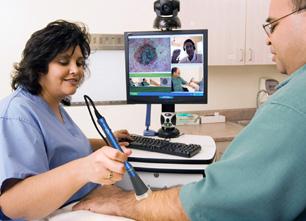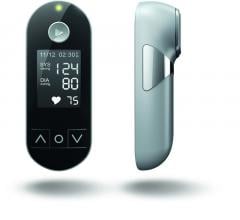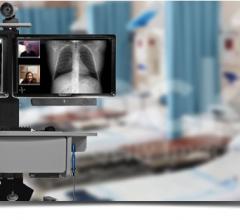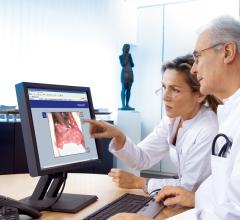
“Information is the lifeblood of modern medicine. Health information technology is destined to be its circulatory system.”(1) When Dr. David Blumenthal’s words appeared in the New England Journal of Medicine(2) last month, he was referring to the IT infrastructure the Department of Health and Human Services is building across the United States. But his words transcended national borders and were heard around the globe.
This is not a glossy vision of the future but a clear view of today’s reality as radiology discovers new ways to deliver modern medicine to remote regions of the world. One U.S.-based non-profit organization (NGO) that is capitalizing on this trend in radiology is Shoulder to Shoulder. With 20 year’s of NGO know-how, Shoulder to Shoulder is optimizing the existing global IT infrastructure to build a bridge to connect advanced healthcare in the U.S. and a resource-challenged population in Honduras.
At the inauguration of its sixth primary care clinic in Honduras, Shoulder to Shoulder will demonstrate how a suite of teleradiology and telemedicine technology is the lifeblood of this new clinic. Equipped with digital X-ray, computed radiography, PACS, ultrasound and a high-definition telemedicine camera, physicians will acquire medical images and send them via PACS to volunteer radiologists and other physicians associated to Shoulder to Shoulder in the U.S. Radiologists will be on hand to read the cases, provide a diagnostic report and transmit them back via PACS to the clinic in Honduras.
Simultaneously, the telemedicine unit will be used to transfer ECG images for interpretation in the U.S. and the ultrasound probe for obstetric, abdominal, and vascular imaging. Other general applications supported by the telemedicine system include otolaryngology and ophthalmology examinations.
“This is a comprehensive set of primary care tools. It is important because it is a model for providing high-tech care, including expert specialty consultations to some of the most remote and isolated areas of the developing world. With the addition of this technology, poor people have access to the same set of services that any well equipped health center in the United States has access to. We not only want to provide care but excellent care to the people in those communities, and the technology will enable us to do what we have never been able to do before,” said Jeffery E. Heck, M.D., who is the executive director and founder of Shoulder to Shoulder, and a professor at the University of North Carolina.
“Digital radiography has enabled us to jump two generations of technology in imaging techniques. In most poor areas of the world, only wet reads are available and the quality of the images are generally poor,” Dr. Heck said. “We are leaping into the most advanced technology, which is digital radiography, allowing high-resolution radiographs to be viewed by local primary care providers and when needed, radiologists in the U.S.”
In primary care medicine, 20 percent of visits by a primary care physician involve radiographic imaging, noted Dr. Heck. Until now, our clinics in rural Honduras did not have the benefits of these services.
“For example, in the past, when a person was discovered with presumed tuberculosis they would be treated on the basis of a sputum specimen alone and there would not be a good way monitoring progress,” said Dr. Heck. “The X-ray can help us make an accurate diagnoses and monitor progress of treatment.”
Instrumental in garnering the equipment and IT solutions donated by U.S. medical device providers, Hayley Holland, director of research and grants, Shoulder to Shoulder Inc., was surprised at the outpour of generosity from the medical community. Taking the initiative, GlobalMedia donated the telemedicine equipment, and MedWeb followed suit, supporting the project with a gift of its Web-based PACS (picture archiving and communication system). Meanwhile, MinXray provided the digital X-ray system, as did iCRco with the computed radiography unit. Finally, Shoulder to Shoulder acquired the ultrasound probe through GlobalMedia.
“I am elated that there was a show of humanitarianism in this effort, and it was amazing how once one donor committed, another followed; there was a domino effect. It was also a testament to the powerful role IT plays in healthcare,” said Holland.
Phillip Silberberg, M.D., a pediatric radiologist, Kosair Children's Hospital, Louisville, Ky., and editorial advisor to Imaging Technology News, also played a key role in encouraging donations for the inauguration of the clinic.
”The 30,000 or more people living in the area surrounding the clinic did not previously have access to X-ray or ultrasound. With the equipment that has been obtained, not only will these images be available but they can be transmitted immediately to centers of excellence within Honduras and within the United States and elsewhere for consultation and collaboration," said Dr. Silberberg. "In addition, the world of telemedicine is also brought to this area, a modality that follows in the path of teleradiology. This will be a major new paradigm shift as images of the entire body, including the skin, ears, nose and throat, heart and breathe sound, ECGs, endoscopies, will also be transmittable in the same fashion.”
Principle to Shoulder to Shoulder’s governing mission is to provide a model for sustainable healthcare. With these technologies newly available to them, these remote Honduran clinics have access to a network in the global medical community.
“It is one more thing that enables us to provide quality care at the local level without having to wait for a specialist to arrive,” said Dr. Heck.
References: 1, 2. Blumenthal, D. Launching HITECH. NEJM. Dec. 30, 2009.
Shoulder to Shoulder (www.shouldertoshoulder.org
GlobalMedia Group, LLC provides the The TotalExam examination camera is the first high-definition capable, digital exam camera to combine dual-focus, freeze frame capture, and electronic image polarization in one medical device. This multipurpose digital camera has wide applications in primary care, emergency medicine/trauma care, dermatology, ophthalmology, wound care and is an excellent device to document abuse. In addition to the exam room, this very portable, light-weight camera, can be used for imaging requirements associated with educational life science applications and even autopsies. Using the TotalExam camera in conjunction with GlobalMedia's newest CapSure “Store-and-Forward” software solution, care providers can manage client medical images within the most popular EMR (Electronic Medical Record) system or the pan-Canadian iEHR (Interoperable Electronic Health Record) system.


 July 23, 2021
July 23, 2021 







